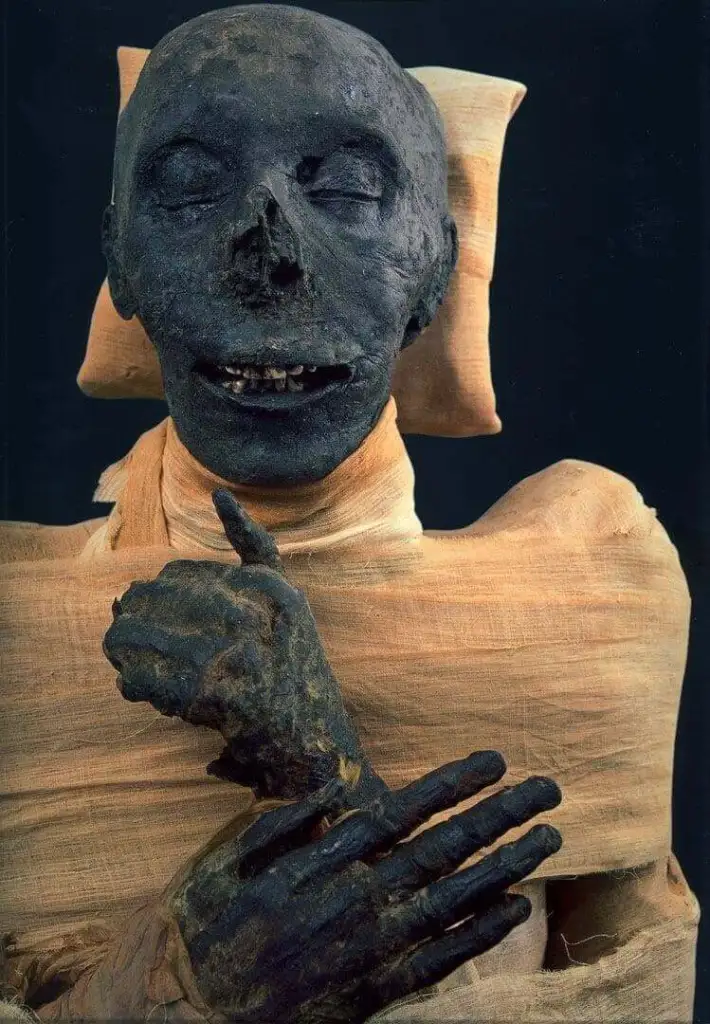The mummy of King Thutmose III was moved from its original burial place in tomb KV34, located in the Valley of the Kings, to the Deir el-Bahari Royal Cache (DB320) in his original middle coffin. King Thutmose III, who was keen on leaving his mark on his expanding empire, was highly active throughout Egypt and Nubia.
Under his guidance, Egypt undertook at least 17 major military expeditions. He also left behind evidence of extensive building programs, including the “Akh-Menu,” a temple in the precinct of Amun-Re at Karnak, where he carved a king list recording the names of his predecessors. Unfortunately, the mummy was severely damaged by tomb-robbers, likely during the 21st Dynasty (ca. 1069-945 BC). When they relocated the royal mummies, they had to use narrow wooden splints to hold the body together. Macroscopic measurements of the body indicated a height of about 1.63 meters (5 feet 4¼ inches). His hands were crossed over his chest in the Osirian position.

In the last years of his life, Thutmose appointed his son Amenhotep II, born to his second wife, Merytre-Hatshepsut, as co-regent. When he died, he was laid to rest in a remote corner of the Valley of the Kings in western Thebes. Among the ancient Egyptian kings, Thutmose III stands out to modern historians as one who nearly comes to life through his records. Though expressed in the boastful and extravagant language considered appropriate for a king’s exploits, these records leave little doubt about his abilities as a soldier and a statesman, as well as an athlete and a hunter of lions, wild cattle, and elephants.
From his mummy, it is known that he was a small man, not above five feet three inches (1.6 meters) in height. His statues depict a youthful, smooth face with a large, high-bridged nose and a pleasantly smiling mouth.
Military Achievements
Thutmose III repeatedly demonstrated his military prowess in Nubia, Phoenician ports, the valuable trade center of Kadesh, and the kingdom of Mitanni in modern-day Syria and Turkey. Over 17 campaigns, he secured more territory than any other king, ultimately controlling Egypt’s largest ever empire. He fought more battles over a longer period and experienced more victories than Alexander the Great and Julius Caesar.

In addition to his numerous military accomplishments, art and architecture flourished under Thutmose III’s reign. He commissioned the construction of over 50 temples, monuments, and other structures. His contributions to the Temple of Karnak, dedicated to several Egyptian gods, were the greatest of any king.
Interest in the Natural World
Thutmose III was also known for his interest in the natural world. At Karnak, he commissioned the construction of a “botanical garden,” a chamber decorated with images of the exotic flora and fauna encountered during his foreign campaigns. Including his joint reign with Hatshepsut, he ruled for 54 years over a prosperous and powerful Egypt.
Legacy and Treasury
The tomb of Thutmose III (KV34) in the Valley of the Kings is notable for its decoration, which depicts the journey of the sun god through the 12 hours of the night in a style mimicking drawing on papyrus. He was originally buried in a cartouche-shaped sarcophagus, which still lies in his burial chamber. However, like many other royal mummies, he was eventually moved to the mummy cache at Deir el-Bahari.
Thutmose’s artisans reached new heights of skill in painting, with tombs from his reign being the earliest to be entirely painted rather than featuring painted reliefs. The spoils from Thutmose III’s military campaigns—including plunder, taxes, and tribute—greatly enriched Egypt’s treasury, making him the wealthiest man in the world at the time. He also secured human capital from his conquered lands, as the sons of defeated rulers were taken to Egypt and educated at court. These individuals, acclimated to Egyptian ways, returned home sympathetic to Egyptian rule.
Unlike one of his later successors, Ramesses II, who exaggerated his military achievements, Thutmose III genuinely earned the triumphs recorded on the numerous monuments he built. His annals were inscribed on the sanctuary walls at the great Temple of Amun-Re at Karnak.
New Kingdom, 18th Dynasty, reign of Thutmose III, ca. 1458-1425 BC. Now in the National Museum of Egyptian Civilization (NMEC), Cairo. CG 61068.



